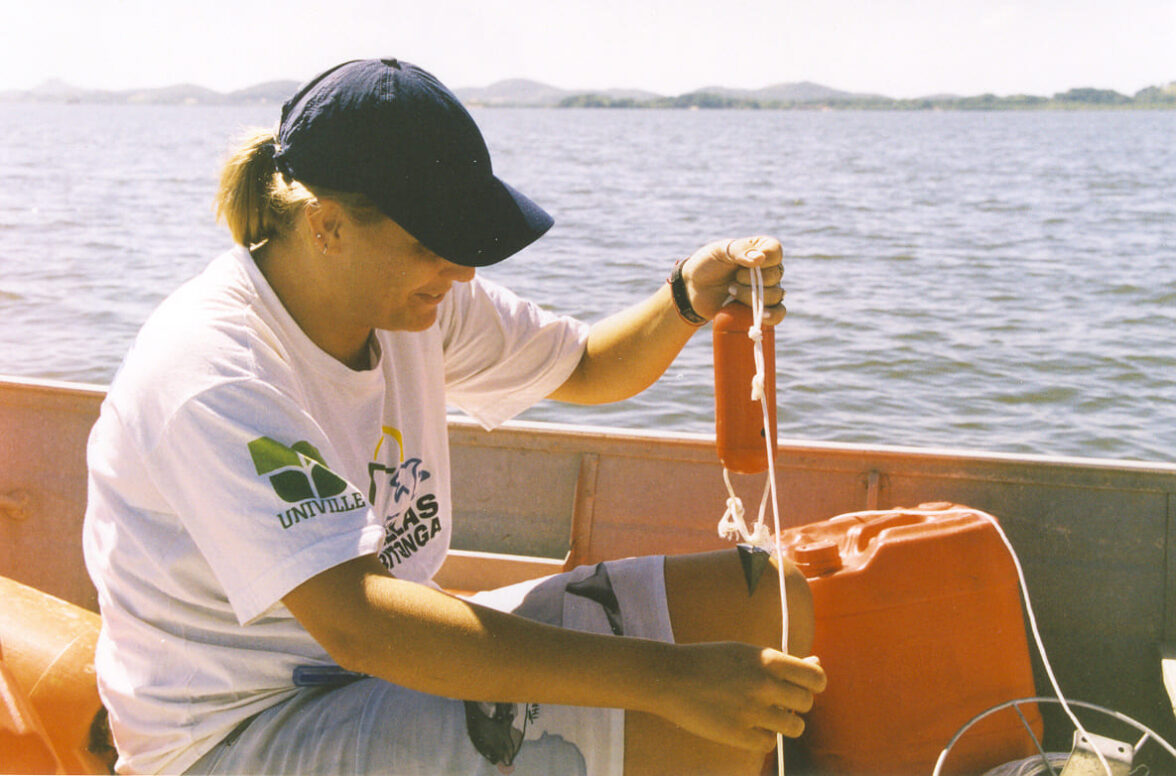The franciscana (Pontoporia blainvillei) is the most endangered coastal dolphin in Brazil and is listed as critically endangered on the ICMBio List of Threatened Species. The main threat to the species is bycatch, i.e., the unintentional capture in fishing nets. Reducing this situation is one of the main challenges for the conservation of the species.
To help mitigate this problem, the Toninhas do Brasil project will test the use of acoustic alarms in nets, in different artisanal fishing realities, in an unprecedented way. Bringing together researchers and institutions from the states of Santa Catarina, Paraná and São Paulo, the project’s research and conservation efforts focus on conducting a pilot project with pingers. Pinger A pinger is a small, battery-powered device that, when attached to fishing nets, emits an ultrasonic signal that alerts dolphins of the threatening nets, thus preventing bycatch. These devices have already been tested by the project in controlled experiments and, according to research coordinator Renan Paitach, presented satisfactory results, with great potential to assist in the conservation of franciscanas. “When the pinger is turned on, the franciscanas stay at a distance of at least 100m, and when it is turned off, they return to the area only a few minutes later. Now, we have to understand how the pinger will work in real fishing contexts, considering operational and socioeconomic aspects”.
At this stage, the challenge is to monitor the experiment in different artisanal fishing realities along the coast. On an ongoing basis, fishermen from five communities will use pingers in their nets, which will be monitored over the next two years. For biologist Marta Cremer, general coordinator of Toninhas do Brasil, the experiment constitutes a great advance in favor of the conservation of the species. “Since its inception, Toninhas do Brasil has focused its efforts on finding alternatives for conservation, always taking into account the needs of local communities. When captures are accidental, thinking about alternatives that reduce these interactions is beneficial for everyone, from animals to fishermen”.
However, the researcher considers that effective measures for the conservation of franciscanas are not simple and must encompass different strategies, such as the use of technologies to reduce accidental captures, fisheries management and other public policy initiatives. With this in mind, the project’s scope of action also includes a diagnosis of the fisheries value chain, holding arenas for discussion with fishermen and other stakeholders, an ocean literacy course for early childhood teachers and a strategic communication plan. In partnership with Petrobras, through the Petrobras Socioenvironmental Program, the project is expected to reach at least 14 communities through all of the aforementioned activities, across the three states, thus effectively contributing to the construction of a cooperative proposal for franciscana bycatch mitigation and for a more sustainable fishing.
The franciscana, the invisible dolphin
The franciscana, scientifically known as Pontoporia blainvillei, is a small dolphin endemic to the Southwestern Atlantic Ocean, occurring only in the waters of Brazil, Uruguay and Argentina. With coastal habits, franciscanas are found at depths of up to 50 meters, forming small family groups. This characteristic makes the species vulnerable to the intense pressure exerted by human activities, especially fishing, which is more intense close to the coast, with bycatch in gillnets being the main risk to the conservation of the species. The franciscana is categorized as “vulnerable”, according to the International List of Threatened Species (IUCN, 2017). However, in Brazil, the species went from “vulnerable” to “critically endangered of extinction” in just ten years.
Between August/2015 and October/2020, 2,696 dead franciscanas were recorded between the states of Santa Catarina and São Paulo. The estimated total population of franciscana for this portion of the coast is less than 7,000 individuals. Its high risk of disappearance, added to the more discreet behavior of the species, which does not usually jump out of water, has led many researchers and sympathizers to call the franciscana the “invisible dolphin”. This nickname, in addition to referring to the characteristics of the species, sheds light on the discussion of how little known the franciscana is and the risk of it disappearing before this situation changes.
Follow the Toninhas do Brasil project on social media: @toninhasdobrasil




